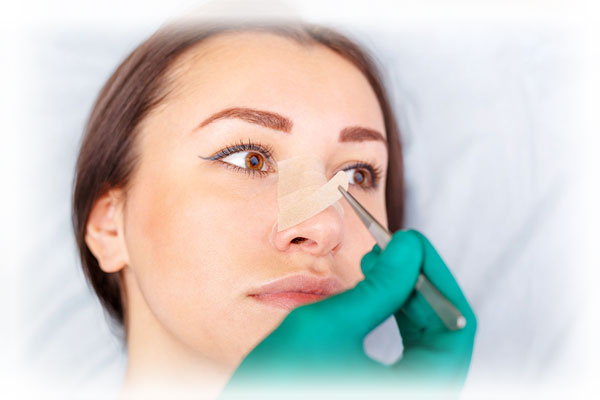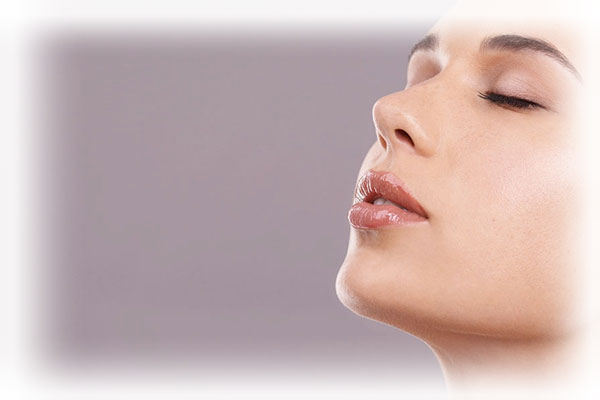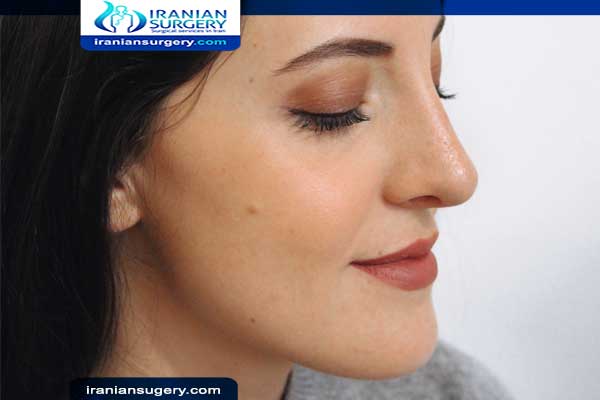Non surgical nose job
Nonsurgical nose job
Fast facts
About:
. Nonsurgical rhinoplasty is also called liquid rhinoplasty.
. The procedure consists of injecting a filler ingredient, such as hyaluronic acid, underneath your skin to temporarily change the structure of your nose.
Read more about : Rhinoplasty podcast with Dr Afshan shah
Read more about : Revision Rhinoplasty podcast with Dr Afshan shah
Read more about : Rhinoplasty surgery , Before and after surgery Videos
Safety:
. Plastic surgeons consider this type of rhinoplasty as efficient and safe, though there are possible complications.
. A common side effect is redness.

Convenience:
. Nonsurgical rhinoplasty is an outpatient procedure, making it far more convenient than surgical alternatives.
. A trained provider can do the procedure in 15 minutes or less.
. In some cases, you can be back at work the same day.
Cost:
. Nonsurgical rhinoplasty is much less expensive than a traditional rhinoplasty.
. Costs vary depending on what kind of filler you choose, the provider you choose and how many injections you need.
Efficacy:
. Patients and doctors report being pleased with the results of nonsurgical rhinoplasty.
. However, it should be noted that in most cases, these results last for 6 months or less.
Read more about : Bulbous nose rhinoplasty
Read more about : Rhinoplasty healing stages
Read more about : Enlarged clitorious condition pictures
Read more about : Nose job simulator
Read more about : Signs of infection after rhinoplasty
About Iranian Surgery
Iranian surgery is an online medical tourism platform in Iran where you can find the best Rhinoplasty Surgeons in Iran. The price of a Rhinoplasty in Iran can vary according to each individual’s case and will be determined based on photos and an in-person assessment with the doctor. So if you are looking for the cost of Rhinoplasty in Iran, you can contact us and get free consultation from Iranian surgery.
What is Nonsurgical Rhinoplasty?
A nonsurgical rhinoplasty also called “liquid nose job” or “15-minute nose job.” is actually a dermal filler procedure that changes the shape of your nose for up to 6 months.
This procedure is ideal for people who are looking to smooth out bumps in their nose or make it look less angular but who aren’t ready for a permanent solution, or are worried about the risks and recovery time involved in a traditional rhinoplasty.
Going under the needle is certainly less complicated than going under the knife for a nose job, but modifying the nose’s shape is never risk-free.
Before Nonsurgical Rhinoplasty
Preparing for treatment
Different filler ingredients have different guidelines for how to prep for your procedure. Your provider should give you detailed instructions on what to do before a nonsurgical rhinoplasty.
The suggestions below are broad guidelines:
. Avoid aspirin, anti-inflammatory medication (such as ibuprofen), vitamin E supplements, and any other blood-thinning supplements in the week before the procedure. If you’re on any blood-thinning medication, make sure your doctor knows it.
. Be aware of your vitamin K levels to reduce the risk of bruising. Eat lots of green, leafy vegetables to boost your vitamin K in the weeks before your procedure.
. Drink plenty of water and eat a meal before your appointment. Don’t overeat, as you may feel nauseous during or after the appointment, but do make sure you’ve eaten something with starch and protein.
Read more about : Nose job simulator
Read more about : Rhinoplasty in Iran
Read more about : Abdominoplasty and Breast reduction and bbl surgery , before and after surgery videos
Risks and side effects
For most people, the only side effect of liquid rhinoplasty they’ll see is a little redness and sensitivity in the area of the injection in the day or two after the procedure.

Other possible side effects include:
. Bruising at the site of the injection
. Swelling
. Filler migration, meaning the injectable ingredient migrates to other areas of your nose or the area under your eyes, creating a “wavy” or “overfilled” look.
. Nausea
The nose is a sensitive area. It’s filled with blood vessels and close to your eyes. That’s why liquid rhinoplasty is somewhat more complicated than other kinds of injectable filler procedures.
A trained and careful plastic surgeon will tend to err on the side of using less filler in your nose rather than overfilling the area.
Possible serious complications include:
. Tissue death
. Vascular complications
. Vision loss
Speak to your doctor right away if you experience:
. Fever
. Blurred vision
. Redness or bruising that spreads and gets worse
. Hives or other symptoms of an allergic reaction
Advantages and Disadvantages of Nonsurgical Rhinoplasty
Advantages
. Nonsurgical rhinoplasty allows you to avoid going under general anesthesia.
. You’ll have a quick recovery.
. After this procedure, you can return to work and your regular activities as soon as the same or next day.
. Results aren’t permanent, so if you’re not pleased with how it looks, it’s just a matter of time before the fillers metabolize.
. The cost of nonsurgical rhinoplasty is much lower than a traditional rhinoplasty.
Disadvantages
. If you’re looking for a dramatic, permanent change to your appearance, this procedure might be disappointing for you.
. There are side effects, such as bruising and swelling.
. There’s the possibility that a misplaced needle could result in visible bleeding under your skin or damage to your vision.
. This is a relatively new procedure, so long-term side effects aren’t well studied yet.
Read more about : Bad smell in nose after rhinoplasty
Read more about : When can i sleep on my side after rhinoplasty?
Read more about : How to clean your nose after rhinoplasty?
Read more about : Revision rhinoplasty
Read more about : Sex after rhinoplasty
Read more about : Rhinoplasty in Iran
During Nonsurgical Rhinoplasty
How does it work?
Nonsurgical rhinoplasty uses dermal filler ingredients to change the shape of your nose. A gel-like injectable ingredient (usually hyaluronic acid) is inserted underneath your skin in the areas where you wish to create smoother lines or volume. Sometimes Botox is also used.
The filler ingredient settles into where it’s injected in your deeper skin layers and holds its shape. This can change the look of your nose for anywhere from 4 months to 3 years, depending on your skin, your desired results, and the ingredient used.
What’s the procedure like?
The procedure for liquid rhinoplasty is fairly simple, especially compared to surgical rhinoplasty. After a consultation where you discuss your desired results, your doctor will have you lie down with your face tilted up. You may have a local anesthesia applied to your nose and the surrounding area so you won’t feel pain from the needle.
After the anesthetic takes effect, your doctor will inject the filler into the area around your nose and maybe the bridge of your nose itself. You might feel a slight pinching or pressure while this is done. The whole process can take from 15 minutes or less to 45 minutes.
Targeted areas
A nonsurgical rhinoplasty targets the bridge, tip, and sides of your nose. Fillers can be injected around any part of your nose to modify its shape.
This procedure works well if you want to:
. Smooth out small bumps in your nose
. Make the tip of your nose more prominent
. Add volume to your nose
. Lift the tip of your nose
Additionally, if you have a mild prominent bump of the bridge of your nose, it can camouflage it and smooth the contour of your nose profile. Liquid rhinoplasty won’t be able to give you your desired results if you want your nose to look smaller or if you’re looking to smooth out more prominent bumps.
After Nonsurgical Rhinoplasty
What to expect after treatment
After liquid rhinoplasty, you may see pain, swelling, and redness where your injection was inserted. Within an hour or two, the injection should start to settle. The redness should start to subside, and you’ll be able to better see your desired results.
. Bring an ice pack to use after your appointment. Ask your doctor if it’s ok to use it to minimize redness and inflammation.
. Results should be fully visible within a week or two. Redness or bruising should completely subside by then.
. As far as downtime, people who swear by liquid rhinoplasty love that there’s practically no recovery time. You can be back to work and your normal activities the very same day.
. Most filler ingredients will dissolve into your skin layer within 6 months. Some filler ingredients will last up to 3 years. No matter what, results of a liquid nose job aren’t permanent.
Read more about : Why do eyes get swollen after nose job?
Read more about : Rhinoplasty cost
Read more about : How to reduce swelling after rhinoplasty?
Read more about : Touching nose after rhinoplasty
Read more about : What to avoid before rhinoplasty?
Read more about : What to eat after rhinoplasty?
Read more about : When can i get a facial after rhinoplasty?



